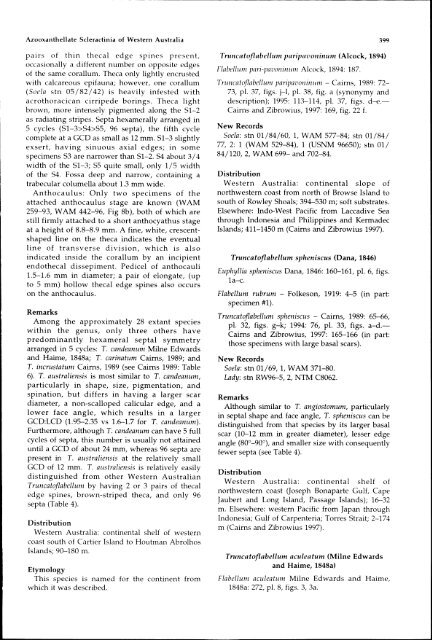Azooxanthellate Scleractinia (Cnidaria: Anthozoa) - Western ...
Azooxanthellate Scleractinia (Cnidaria: Anthozoa) - Western ...
Azooxanthellate Scleractinia (Cnidaria: Anthozoa) - Western ...
You also want an ePaper? Increase the reach of your titles
YUMPU automatically turns print PDFs into web optimized ePapers that Google loves.
AzooxantheIlate ScIeractinia of <strong>Western</strong> Australia<br />
pairs of thin thecal edge spines present,<br />
occasionally a different number on opposite edges<br />
of the same corallum. Theca only lightly encrusted<br />
with calcareous epifauna; however, one corallum<br />
(Soela stn 05/82/42) is heavily infested with<br />
acrothoracican cirripede borings. Theca light<br />
brown, more intensely pigmented along the Sl-2<br />
as radiating stripes. Septa hexamerally arranged in<br />
5 cycles (Sl-3>S4>S5, 96 septa), the fifth cycle<br />
complete at a GCD as small as 12 mm. Sl-3 slightly<br />
exsert, having sinuous axial edges; in some<br />
specimens S3 are narrower than Sl-2. 54 about 3/4<br />
width of the Sl-3; S5 quite small, only 1/5 width<br />
of the 54. Fossa deep and narrow, containing a<br />
trabecular columella about 1.3 mm wide.<br />
Anthocaulus: Only two specimens of the<br />
attached anthocaulus stage are known (WAM<br />
259-93, WAM 442-96, Fig 8b), both of which are<br />
still firmly attached to a short anthocyathus stage<br />
at a height of 8.8-8.9 mm. A fine, white, crescentshaped<br />
line on the theca indicates the eventual<br />
line of transverse division, which is also<br />
indicated inside the corallum by an incipient<br />
endothecal dissepiment. Pedicel of anthocauli<br />
1.5-1.6 mm in diameter; a pair of elongate, (up<br />
to 5 mm) hollow thecal edge spines also occurs<br />
on the anthocaulus.<br />
Remarks<br />
Among the approximately 28 extant species<br />
within the genus, only three others have<br />
predominantly hexameral septal symmetry<br />
arranged in 5 cycles: T. candeanum Mime Edwards<br />
and Haime, 1848a; T. carinatum Cairns, 1989; and<br />
T. incrustatum Cairns, 1989 (see Cairns 1989: Table<br />
6). T. australiensis is most similar to T. candeanum,<br />
particularly in shape, size, pigmentation, and<br />
spination, but differs in having a larger scar<br />
diameter, a non-scalloped calicular edge, and a<br />
lower face angle, which results in a larger<br />
GCD:LCD (1.95-2.35 vs 1.6-1.7 for T. candeanum).<br />
Furthermore, although T. candeanum can have 5 full<br />
cycles of septa, this number is usually not attained<br />
until a GCD of about 24 mm, whereas 96 septa are<br />
present in T. australiensis at the relatively small<br />
GCD of 12 mm. T. australiensis is relatively easily<br />
distinguished from other <strong>Western</strong> Australian<br />
Truncatoflabellum by having 2 or 3 pairs of thecal<br />
edge spines, brown-striped theca, and only 96<br />
septa (Table 4).<br />
Distribution<br />
<strong>Western</strong> Australia: continental shelf of western<br />
coast south of Cartier Island to Houtman Abrolhos<br />
Islands; 90-180 m.<br />
Etymology<br />
This species is named for the continent from<br />
which it was described.<br />
Tnmcatoflabellum paripavoninum (Alcock, 1894)<br />
Flabellum pari-pavonil1l1m Alcock, 1894: 187.<br />
399<br />
Trlll1catoflabellum paripavol1il1l1m Cairns, 1989: 72<br />
73, pI. 37, figs. j-I, pI. 38, fig. a (synonymy and<br />
description); 1995: 113-114, pI. 37, figs. d-e.<br />
Cairns and Zibrowius, 1997: 169, fig. 22 f.<br />
New Records<br />
Soela: stn 01/84/60,1, WAM 577-84; stn 01/84/<br />
77, 2: 1 (WAM 529-84), 1 (USNM 96650); stn 01/<br />
84/120,2, WAM 699- and 702-84.<br />
Distribution<br />
<strong>Western</strong> Australia: continental slope of<br />
northwestern coast from north of Browse Island to<br />
south of Rowley Shoals; 394-530 m; soft substrates.<br />
Elsewhere: Indo-West Pacific from Laccadive Sea<br />
through Indonesia and Philippines and Kermadec<br />
Islands; 411-1450 m (Cairns and Zibrowius 1997).<br />
Truncatoflabellum spheniscus (Dana, 1846)<br />
Euphyllia spheniscus Dana, 1846: 160-161, pI. 6, figs.<br />
1a-
















